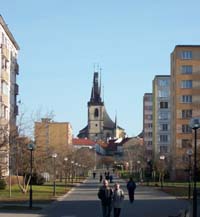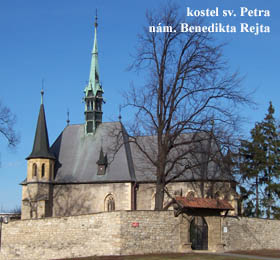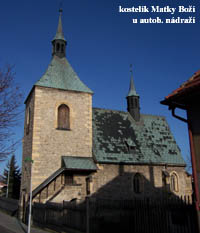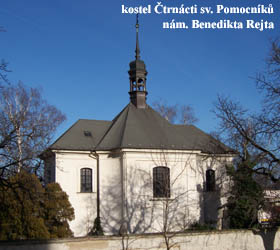History of the Louny Parish

The first Christians came to the central Ohře valley in the 9th century the latest. However, the prehistoric period of our parish can be dated by the time when the first church in Luna settlement was built. It was consecrated to St Peter. The first parish priest was not mentioned until the years 1279 - 1290, which was the time when the royal city was chartered and in the centre stood a parish church of the Elevation of the St Cross (later called the church of St Nicolas). Local priest Bohouš was allowed to be substituted by vicar for the period of his long-time absence in Louny. This would be exercised, with only a few exceptions till the Hussite wars. The Louny priests worked more at court rather than in the ecclestical board. One of the Hussite chronicler Vavřinec z Březové was active in the royal office, he studied the university in Prague and even though he did not receive priest ordination he became a Louny priest.
The Louny church used to be one of the richest in the whole Czech Kingdom since its founder and patron was represented by the ruler himself. That is why the Louny citizens could afford extensive gothic reconstructions of their temple, during which today's high tower was built and the church was re-consecrated to St Nicolas - patron of merchants.
Since the town was founded, a poor Dominican monastery with the church of Virgin Mary and the chapel of St Maria Magdalena and Barbara stood near the Prague Gate by the east walls. Sometimes before the year 1331 the Louny mayor Bero founded a cloister of Magdalens with a church of St Anna at the Benatky suburb and he gave them vast lands towards the hills Raná and Oblík. The order of Sisters of Penitence of St Maria Magalena was originally founded for atoning ex-prostitutes and it was aimed for the atonement of morally endangered women. However, in the 14th century the white ladies were taking care for the sick and pilgrims. Several times the monastery superior in Louny was elected as a prior of Bohemian-Moravian-Austrian province of religious order.
Louny acknowledged Jan Hus already in 1410, when the town received a letter from its Master in which he encouraged the citizens to stick to the good values. Thanks to the letter from the University of Prague a year after Hus's burning at the stake we know that Louny citizens would receive Communion also from the goblet. No wonder, that monks were driven away from the town, even if the catholic priest Mařík was still in Louny in 1422. According to some of the priests, the good people were to flee to five cities: Plzeň, Žatec, Louny, Slaný and Klatovy, in which only they would be safe from the impending end of the world. Soon a Union of Louny, Žatec and Slaný Hussites, which took part in most of the important battles, was found.
 After the wars the town of Louny strived to keep the property left from the destroyed monasteries. It could only keep the villages of the Louny Magdalens' provided that they built a hospital for the poor and the chapel of St Maria Magdalena from the gains in the so-called Žatec suburb. This property became a basis of the church maintenance fund from which the Louny hospital, churches and school were paid. Thanks to the church maintenance villages we have such a splendid church and altar; the school was one of the best in Bohemia etc.
After the wars the town of Louny strived to keep the property left from the destroyed monasteries. It could only keep the villages of the Louny Magdalens' provided that they built a hospital for the poor and the chapel of St Maria Magdalena from the gains in the so-called Žatec suburb. This property became a basis of the church maintenance fund from which the Louny hospital, churches and school were paid. Thanks to the church maintenance villages we have such a splendid church and altar; the school was one of the best in Bohemia etc.
Apart from the small persecutory group of Bohemian Brothers, who apparently used to meet in Dalibor Tower, until the Battle of Bílá Hora the town remained more or less allegiant to utraquism - moderate Hussite movement of communion in both kinds. Their symbol, the goblet, shined from the tall church tower as well as from both the town gates. Wine was harvested from the hillsides of the České Středohoří mountains, and during the Latin and Czech liturgy Jan Hus was celebrated together with other saints.
At that time the king did not have the patronal rights of the church and the priests working in Louny were chosen by the town council. They were one of the best and it was not unusual when later they were elected as administrators of communion-in-both-kinds consistory. Havel Cahera was one of the more known ones. He was a chaplain in Louny for two years. As an Utraquist superior, he was by turns inclined to Luther and the Catholic. After all he married and died as an innkeeper. Then there was a Lutheran Martin Klatovský, who between the years 1526-1539 was the first one who had the Dean's degree and the Louny Parish was now called deanery. Apart from the dean, there were also chaplains in the town, at St Peter's there was a vice parish priest and at St Maria Magdalena's there was a hospital priest.
 There are many monuments from the time of communion in both kinds. Instead the ruined Dominican temple a church of God Mother was built in the Prague suburb. The church of St Peter's at the other side of the town went through a thorough late-gothic reconstruction. The biggest attention was devoted to the dean temple of St Nicolas. After the great fire of the town the Louny citizens chose the royal architect Benedikt Rejt.
There are many monuments from the time of communion in both kinds. Instead the ruined Dominican temple a church of God Mother was built in the Prague suburb. The church of St Peter's at the other side of the town went through a thorough late-gothic reconstruction. The biggest attention was devoted to the dean temple of St Nicolas. After the great fire of the town the Louny citizens chose the royal architect Benedikt Rejt.
Thanks to the local school, one of the best in Bohemia, whose rectors were the most outstanding humanists, there was an excellent Czech and Latin choir accompanied by organ and other instruments. In the archive you can still see the costly decorated graduals from which the men of letters used to sing. In the second half of the 16th century, a known renaissance sculptor Vincent Strašryba worked in Louny. He is for exampel the author of the arcade cemetery wall around the St Peter's and a fountain with biblical scenes which unfortunately is not preserved.
The Battle of Bílá Hora meant a turning point in the development of the parish orientation. For five years the parishioners were reluctant to convert to Catholicism and they tend to flee to the nearby villages to the priests of the communion of both kinds. The persistent Jesuit preaching and mainly Spanish general don Martin de Hoeff Huerty's military help made nearly all the Louny citizens to unify the religion with "His Emperor's Grace". The Jesuits confiscated all the heretic literature and soldiers removed the wooden choir from the church and all the monuments reminding the Utraquist history. However the "non-Catholics" returned several times with the Saxons and Swedes during the Thirty-year war. At the end of the war Louny was exhausted, desolate and almost deserted.
The Catholic baroque took roots in Louny (66 years after the Battle of Bílá Hora the city could choose a priest again and he was not nominated by the archbishop or by the King's council anymore). The baroque monuments are not adrift of the period before the Battle of Bílá Hora. First of all it is the Marian Column which used to stand in the Prague suburb. It was made by Jan Jiří Bendl, an author of Immaculata at the Old Town Square in Prague pulled down after the fall of the Austrian Empire. Between the years 1692-1698 a known architect Antonio della Porta built a new hospital building. Soon a new baroque deanery was built. In the main temple opposite, after the pews and a few side altars were carved, the monumental project of three giant altars at the end of the nave was put through.
 Louny was struck by several big epidemics, for prevention of which many beseeching processions were held. While during the first plague stroke in 1680 the Louny citizens built only the altar of St Sebastian and Roch in the main church, after the prevention of the second one, in 1714 at the very end of the Žatec suburb near the plague cemetery the church of The Holy Trinity and Fourteen St Helpers was built. Near the church there was a hermitage where a friar - Ivanit, who worked as a sexton.
Louny was struck by several big epidemics, for prevention of which many beseeching processions were held. While during the first plague stroke in 1680 the Louny citizens built only the altar of St Sebastian and Roch in the main church, after the prevention of the second one, in 1714 at the very end of the Žatec suburb near the plague cemetery the church of The Holy Trinity and Fourteen St Helpers was built. Near the church there was a hermitage where a friar - Ivanit, who worked as a sexton.
The reforms of Joseph II meant a real blow. The hermitage by the chapel of Fourteen Helpers and confraternities of men-of-letters were the first ones to be affected by the orders, until finally in 1789 the churches of St Peter, the God Mother and Fourteen St Helpers were closed down. Their equipment was either confiscated or sold in auctions. The pews and some of the bells were bought by devoted Louny citizens who left them in the churches, but many altars and organs were taken to outlying churches. Most of the property was still owned by Church, only the church of St Peter became the possession of the city of Louny. But Louny did not always take the oldest monument in consideration. Many stones from the beautiful renaissance cemetery wall and even the lime from the marble tombstones were used for building the city brewery. The chapel of St Maria Magdalena met a worse destiny; in 1834 it was pulled down because of the dilapidated state.
During the 19th century many clergymen played an important role in the advancement of the Czech language and they belonged among important awakeners (Daneš in Peruc, Třebízský in Panenský Týnec). There was a dean, two chaplains and after the Grammar School was found there were already three catechists. These priests served both the emperor and national interests. Thanks to the chaplain Josef Pelc's suggestion the Czech language was used in the Louny town hall. On the other hand, when the Louny citizens refused to take part in the establishing local school committee, the dean Linhart did hot join them and became the local inspector. In the following demonstrations Louny citizens broke the deanery windows.
The formation of the Republic affected the domestic church mainly by breakaway of unsatisfied priests and by the formation of the independent Church of Czechoslovakia. And it was mainly Alois Vosátka, a favourite chaplain, who brought most of the Catholics in Louny round to the new religious movement. The following prolonging disputes over the temple of St Nicolas lead to its closure (apparently because of security measures). The Catholics moved to the church of Fourteen Helpers and the Czechoslovak church lied up to a girls' school art room till they built their own house of worship in 1932. The Protestants on the other hand followed a different way when they unified the Helvetic and Augsburg creed into the Evangelical Church of Bohemian Bretheren. At the end of the century they would gather in the church of St Peter and then finally in 1932 they had their own building.
The good Catholic reputation was supported when 18 Vincent Sisters came to a newly built hospital, where they had their own chapel. In the 30th two Urbanite Sisters lived in chaplain's vicarage behind the deanery and they worked with socially weak people and with the young.
The Parish was stricken by both the world wars (e.g. the big bells of Louny churches were requisitioned), but bigger losses were brought by the victory of Communism. Nuns had to leave the hospital and Chaplain Jindřich Tomíček was imprisoned. The parish administrators, now without chaplains, had to look after more and more surrounding churches, where there was no priest. In spite of that from the end of the 60th overhaul reconstruction of the whole church of St Nicolas could be done. As for the modern workings, the biggest input was from father Milan Bezděk.
The Christian churches are enjoying renaissance but there are also many sects that have appealed many people. Since the beginning of the 21st century there are chaplains who help the dean and also perform their one-year deacon practice. More and more altar boys, big and small children choir and also regular services in the old people's home bear the witness to the Louny Catholics' interest and effort. May the Louny Parish still grow in the name of Christ.

